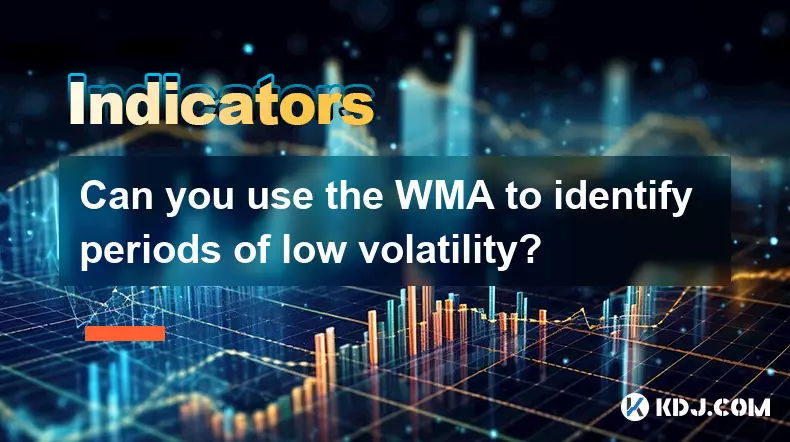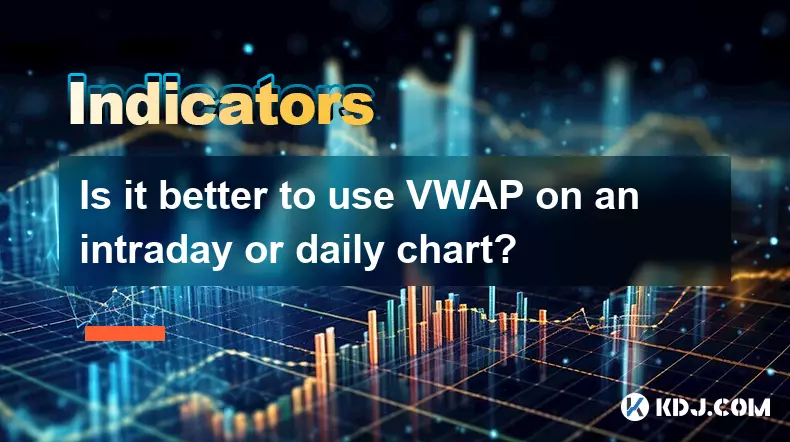-
 bitcoin
bitcoin $108842.957301 USD
-1.88% -
 ethereum
ethereum $3931.777121 USD
-1.66% -
 tether
tether $1.000186 USD
-0.03% -
 bnb
bnb $1153.250882 USD
-2.20% -
 xrp
xrp $2.367904 USD
-1.94% -
 solana
solana $186.182050 USD
-4.20% -
 usd-coin
usd-coin $0.999997 USD
0.00% -
 tron
tron $0.316949 USD
-1.00% -
 dogecoin
dogecoin $0.190780 USD
-3.12% -
 cardano
cardano $0.651324 USD
-2.67% -
 hyperliquid
hyperliquid $37.141055 USD
-0.85% -
 ethena-usde
ethena-usde $0.999224 USD
-0.09% -
 chainlink
chainlink $17.579031 USD
-2.47% -
 bitcoin-cash
bitcoin-cash $509.426284 USD
-2.79% -
 stellar
stellar $0.315298 USD
-2.93%
Can you use the WMA to identify periods of low volatility?
The Weighted Moving Average (WMA) helps traders identify low-volatility phases in crypto markets by flattening during consolidation, signaling potential breakouts when combined with volume analysis and other indicators.
Oct 12, 2025 at 01:54 am

Understanding the Weighted Moving Average in Volatility Analysis
1. The Weighted Moving Average (WMA) assigns greater importance to recent price data, making it more responsive to new information compared to simple moving averages. This sensitivity allows traders to detect shifts in momentum and potential turning points in asset prices within the cryptocurrency markets. Because of its structure, WMA can reflect changes in price action faster, which is crucial when assessing short-term market behavior.
2. When volatility is low, price movements tend to consolidate, resulting in tighter ranges and smaller fluctuations over time. In such environments, the WMA line appears flatter and moves with less deviation. Observing the slope and spacing of the WMA can provide visual cues about the current state of market activity. A nearly horizontal WMA suggests that upward and downward pressures are balanced, often indicating reduced market interest or anticipation before a breakout.
3. Traders often combine WMA with other technical tools like Bollinger Bands or Average True Range (ATR) to validate low-volatility conditions. For instance, if the WMA flattens while the Bollinger Bands contract inward, this confluence strengthens the signal of decreasing volatility. These patterns are especially useful in crypto trading, where sudden spikes in volume and price can follow extended quiet periods.
4. Cryptocurrency assets frequently experience phases of consolidation after sharp rallies or sell-offs. During these intervals, the WMA may show minimal directional movement, signaling that the market is digesting prior moves. Identifying these zones helps traders prepare for potential breakouts. Positioning entries or setting alerts around these areas can improve timing when volatility resumes.
5. While WMA alone does not measure volatility directly like standard deviation-based indicators, its rate of change serves as an indirect proxy. A slowing rate of change in the WMA values across consecutive candles indicates diminishing momentum, often associated with tightening price action. Monitoring how quickly the WMA adjusts to new prices gives insight into whether the market is becoming more stable or unstable.
How WMA Reacts During Market Consolidation
1. In ranging markets, where prices oscillate between support and resistance without clear direction, the WMA tends to move laterally. This behavior contrasts with trending phases, where the WMA exhibits a consistent upward or downward trajectory. Spotting this lateral movement helps identify periods where buying and selling forces are in equilibrium.
2. Low volatility often precedes significant price moves, particularly in high-leverage crypto derivatives markets. When the WMA remains compressed over several candlesticks—especially on hourly or four-hour charts—it may suggest that traders are hesitant to commit capital. This hesitation typically ends with a surge in volume and price acceleration once a decisive trigger occurs.
3. Algorithmic trading systems frequently monitor WMA plateaus to detect consolidation zones. Automated strategies may place pending orders above and below these ranges, anticipating a breakout. Retail traders can replicate this approach by observing how long the WMA stays within a narrow band and combining it with volume analysis for confirmation.
4. On lower timeframes, such as 5-minute or 15-minute charts, brief flattening of the WMA might represent temporary lulls rather than sustained low volatility. It becomes more meaningful when observed across multiple timeframes simultaneously. For example, if the 4-hour and daily WMAs both show flat tendencies, the signal gains credibility.
5. Some advanced charting platforms allow users to calculate the derivative of the WMA—essentially measuring its slope over time. A near-zero slope value corresponds to minimal price change, reinforcing the presence of low volatility. Integrating this metric into custom dashboards enhances precision in identifying stagnant market phases.
Combining WMA With Volume Metrics for Confirmation
1. Volume plays a critical role in validating low-volatility readings derived from WMA behavior. Declining volume alongside a flattening WMA supports the idea that market participation is waning. In Bitcoin or Ethereum trading, such combinations often appear before major news events or macroeconomic announcements.
2. Sudden drops in trading volume on major exchanges, combined with a stagnant WMA, can indicate investor indecision. Market makers may pull back during these times, leading to tighter spreads but also increased fragility. Once volume returns, even small trades can trigger outsized price swings due to thin order books.
3. Stablecoins’ trading volumes can also offer context. If spot volume in USDT pairs declines across top altcoins while the WMA flattens, it reflects reduced speculative activity. Conversely, rising futures open interest during WMA stagnation could hint at accumulating leverage ahead of a potential move.
4. On-chain metrics such as exchange inflows and outflows can complement WMA observations. For example, a flat WMA coupled with large withdrawals from exchanges might suggest accumulation despite apparent price inactivity. This divergence underscores that price stability doesn’t always mean lack of strategic movement.
5. Traders who integrate WMA patterns with volume profiles gain a clearer picture of true market conditions beyond surface-level price action. This layered analysis is particularly effective in spotting coiling behavior in volatile assets like meme coins or newly listed tokens on decentralized exchanges.
Frequently Asked Questions
Q: Can WMA be used alone to confirm low volatility?A: No single indicator should be used in isolation. While WMA can highlight potential low-volatility phases through reduced slope and minimal deviation, it lacks a standardized scale for volatility measurement. Pairing it with tools like ATR or historical volatility calculations improves accuracy.
Q: What timeframe is best for detecting low volatility using WMA?A: Longer timeframes such as 4-hour or daily charts provide more reliable signals. Shorter intervals are prone to noise, making it difficult to distinguish genuine consolidation from random price fluctuations. Multi-timeframe analysis increases confidence in identified patterns.
Q: Does a flat WMA always lead to a breakout?A: Not necessarily. A flat WMA indicates equilibrium, but continuation of the range is just as likely as a breakout. Additional confirmation from volume spikes, candlestick patterns, or order book dynamics is required before expecting a directional move.
Q: How does WMA compare to EMA in spotting low volatility?A: Both WMA and EMA emphasize recent prices, but WMA applies linear weighting, giving the most recent data the highest multiplier. This makes WMA slightly more sensitive to immediate changes, potentially offering earlier hints of volatility contraction or expansion compared to EMA.
Disclaimer:info@kdj.com
The information provided is not trading advice. kdj.com does not assume any responsibility for any investments made based on the information provided in this article. Cryptocurrencies are highly volatile and it is highly recommended that you invest with caution after thorough research!
If you believe that the content used on this website infringes your copyright, please contact us immediately (info@kdj.com) and we will delete it promptly.
- Cardano, Dogecoin, and the Token Rally: What's the Hype?
- 2025-10-17 22:45:16
- Milk Mocha Meme Coin: Last Call for Whitelist & Early HUGS Gains!
- 2025-10-17 22:45:16
- Crypto's New Sweetheart: Milk & Mocha's $HUGS Token and the Early Rounds Advantage
- 2025-10-17 22:25:12
- Crypto Picks for 2025: Blazpay Presale and Emerging Trends
- 2025-10-17 22:50:12
- Meme Coins: Riding the Early Bird Gold Rush
- 2025-10-17 23:05:12
- Shannon Man, Cash Prizes, and Coin Games: A New York Minute on a Georgia Arrest
- 2025-10-17 22:50:12
Related knowledge

What's the main difference between VWAP and TWAP?
Oct 12,2025 at 11:54am
Understanding VWAP and Its Role in Crypto Trading1. Volume Weighted Average Price (VWAP) is a trading benchmark that calculates the average price of a...

How do you identify exhaustion moves using VWAP and its bands?
Oct 12,2025 at 08:00am
Understanding the Role of Decentralized Exchanges in Crypto Trading1. Decentralized exchanges (DEXs) operate without a central authority, allowing use...

Is it better to use VWAP on an intraday or daily chart?
Oct 15,2025 at 02:01am
Intraday Trading and the Role of VWAP1. Intraday traders frequently rely on VWAP (Volume Weighted Average Price) as a dynamic benchmark for assessing ...

How do you use VWAP to scale in and out of positions?
Oct 14,2025 at 02:19am
Understanding VWAP as a Dynamic Benchmark1. The Volume Weighted Average Price (VWAP) is not just an indicator—it functions as a dynamic benchmark that...

What are the main advantages of using VWAP over EMA?
Oct 11,2025 at 02:18am
Main Advantages of Using VWAP Over EMA1. Volume-Weighted Average Price (VWAP) incorporates trading volume into its calculation, offering a more accura...

How do you use VWAP on different chart types like Heikin Ashi?
Oct 11,2025 at 05:01pm
Understanding VWAP in the Context of Heikin Ashi Charts1. The Volume Weighted Average Price (VWAP) is a powerful analytical tool commonly used by trad...

What's the main difference between VWAP and TWAP?
Oct 12,2025 at 11:54am
Understanding VWAP and Its Role in Crypto Trading1. Volume Weighted Average Price (VWAP) is a trading benchmark that calculates the average price of a...

How do you identify exhaustion moves using VWAP and its bands?
Oct 12,2025 at 08:00am
Understanding the Role of Decentralized Exchanges in Crypto Trading1. Decentralized exchanges (DEXs) operate without a central authority, allowing use...

Is it better to use VWAP on an intraday or daily chart?
Oct 15,2025 at 02:01am
Intraday Trading and the Role of VWAP1. Intraday traders frequently rely on VWAP (Volume Weighted Average Price) as a dynamic benchmark for assessing ...

How do you use VWAP to scale in and out of positions?
Oct 14,2025 at 02:19am
Understanding VWAP as a Dynamic Benchmark1. The Volume Weighted Average Price (VWAP) is not just an indicator—it functions as a dynamic benchmark that...

What are the main advantages of using VWAP over EMA?
Oct 11,2025 at 02:18am
Main Advantages of Using VWAP Over EMA1. Volume-Weighted Average Price (VWAP) incorporates trading volume into its calculation, offering a more accura...

How do you use VWAP on different chart types like Heikin Ashi?
Oct 11,2025 at 05:01pm
Understanding VWAP in the Context of Heikin Ashi Charts1. The Volume Weighted Average Price (VWAP) is a powerful analytical tool commonly used by trad...
See all articles










































































